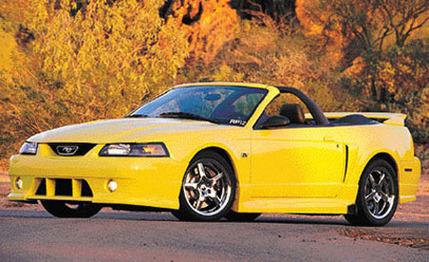 Specialty File
Specialty File
In the past 10 years, we've picked the Chevrolet Camaro over the Ford Mustang in every comparison the two have battled in--except for one. That solo Mustang victory came in a comparison of the pony cars equipped with V-6 engines. Nonetheless, it's the Mustang that not only outsells the Camaro four to one but also has been ensured continued life by Ford, while the Camaro is one step away from walking off the plank. Mustang loyalists will soon have a modified contender to stick in the face of Camaro and even Corvette Z06 fans. Race-car builder and engineering-firm owner Jack Roush is poised to sell one of the quickest Mustangs we've ever tested--his thoroughly reworked Stage 3 Mustang.
Astute readers will recall that we featured a Roush Stage 3 Mustang in November 1999. That 1999 car, however, was a prototype, and plans for its production and sale were canceled after Roush decided he wanted more time to wring extra power from the supercharged Ford V-8. Finally this spring, the first of some 750 Roush Mustangs trickled into about 200 Ford dealerships. We say dealers because the Stage 3 is not a tuner car. Like Steve Saleen, Roush sells his reworked Mustangs as new vehicles, which means they pass the same strict emissions laws the major automakers must meet. Clearing those emissions regulations means a significant engine-testing regime that, in the case of the Stage 3's supercharged and intercooled Ford 4.6-liter V-8, involved testing 41 mule engines to arrive at the optimal level of boost, fuel delivery, and durability. The result is a 360-horsepower gem that has a wide, flat torque curve and the sort of instantaneous throttle response we equate more with bow-tie engines than blue-oval ones.
With the blown engine strapped to the stock Mustang five-speed manual gearbox (an automatic transmission is available) and a 3.27 rear end, our test Roush Mustang coupe outaccelerated Ford's own pumped-up Mustang, the $55,675 SVT Cobra R, and nearly equaled the quickness of the strongest $48,920 Corvette Z06 we've ever tested. Sixty mph arrives in a raucous 4.3 seconds (4.5 seconds for the Cobra R, 4.3 for the Z06); 100 takes just 10.1 seconds (Cobra R, 10.7; Z06, 10.0); and the quarter-mile flashes by in 12.9 seconds at 111 mph (Cobra R, 13.0 at 111 mph; Z06, 12.7 at 113 mph). The Stage 3's top speed of 164 mph is 4 mph less than the Z06 flat out and 13 less than the Cobra. Roush's coupe version starts at $40,704, and the convertible opens for $4255 more. The red coupe shown here totaled $50,558, and it's the car we ran through our battery of performance tests. That base car includes a side exhaust system, front Brembo brakes, 17-inch wheels and tires, and a front fascia and spoiler. Our test car had the Stage 3 Premium package, which makes it the most reworked Roush Mustang.
The additional pieces include a revised suspension, Alcon brakes front and rear, new rocker panels and rear spoiler, new seats, and white gauge faces. Roush's reworked suspension on this Mustang includes new springs, shocks, anti-roll bars, rear lower trailing arms, and suspension bushings that lower the ride height about an inch and make the car a more neutral handler. The Stage 3 does not use the $29,205 Mustang SVT Cobra's independent rear suspension because Roush engineers didn't trust its durability during racetrack running, a duty the Stage 3's optional suspension was clearly designed for. Unlike stock Mustangs whose front ends plow mercilessly in corners, the Stage 3 is more neutral and stable when cornering hard. Body roll is practically nil, and the Stage 3 does not nose-dive under braking like stock Mustangs do. Roush claims his Stage 3 Mustang can generate more than 1.00 g on the skidpad, but the best we could muster was 0.91.
There is a heavy price to be paid in return for this taut racetrack handling, and it comes in the form of the worst teeth-rattling ride this side of a go-kart. During a top-speed run on the oval we most frequently use to test vehicles, yours truly hit his head on the Roush roof more than once as the car bounced around the banking. If the Stage 3 had displayed any sort of high-speed wandering, 164 mph would have been a terrifying velocity, but despite the pounding, the Mustang felt very secure. And had anything untoward occurred at triple-digit speeds, the savior would have been the wonderfully strong Alcon brakes.
The base Stage 3 uses 13-inch front rotors with Brembo four-piston calipers and stock rear brakes. Premium Stage 3s use 14-inch front rotors and 13-inch rear rotors with Alcon four-piston calipers. The Premium brakes we tested displayed exceptional fade resistance. Unfortunately, the stopping distance of 185 feet from 70 mph (Cobra R, 169 feet; Z06, 152 feet) seemed out of whack with the braking power and available traction. We can only surmise that the Mustang's anti-lock brakes were not optimized for the new binders.
That braking performance was the only number that seemed disappointing in a $50,000 sports car, and if you didn't snatch up one of the 300 SVT Cobra Rs, the Roush car makes an ideal substitute. Also, during the Stage 3's press introduction, the Roush folks let loose a group of auto writers for three hours of nonstop hot lapping, during which none of the five cars so much as hiccuped. Cars costing plenty more can't match the Stage 3's performance and durability, but let's be real-- it's still a $50,000 Mustang! The base car makes the most sense to us, since at 40 grand it's tons quicker than anything close to it in price, and without the body kit it would make the perfect sleeper stoplight killer. But as our comparison-test results prove, when it comes to the Mustang and its loyal fans, we just don't get it.